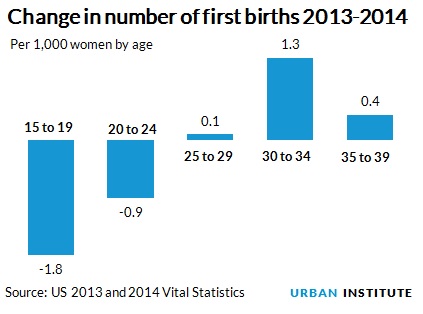
A new brief by the National Center for Health Statistics reports that US births rose by 53,743 from 2013 to 2014. This is the first increase in US births in seven years, following a period of dramatic decreases since the recession.
This new report of rising fertility has various media outlets asking if (or declaring that) the “baby recession” is over—if US fertility is returning to what it was before the recession.
Looking closely at the demographics, there are four reasons why the “baby recession” probably isn’t over, and is unlikely to end soon.
-
53,743 births is actually a small increase.
In 2014, 3,985,924 babies were born, compared with 3,932,181 in 2013—but this is still 330,309 fewer births than the 4,316,233 in 2007, before the recession.
-
Births increased, but birth rates barely changed from 2013 to 2014.
Births are increasing because the population is increasing, but that alone does not signal a change in behavior. In the United States, as the bigger millennial generation ages, it’s replacing the smaller gen X at peak reproductive ages. The increase of 53,743 births represents a 1.4 percent relative increase in fertility from 2013 to 2014. According to our calculations, of that 1.4 percent, 1.2 percentage points are simply an increase in the effective size of the reproductive age population. Only 0.2 percentage points are an increase in fertility rates, controlling for age.
Birth rates are a measure of people’s childbearing behavior, and that behavior is essentially unchanged from 2013 to 2014.
-
First birth rates continued to decrease from 2013 to 2014.
During the recession, some women and couples who had already started their families stopped having children in hopes that times would improve. In the immediate aftermath of the recession, some resumed expanding their families. This is a very small, very temporary effect, and it accounts for more than all of the 0.2 percentage point increase in birth rates from 2013 to 2014.
If we look only at first birth rates as a measure of family formation, we see that family formation rates continued their post-recession decline, from 24.7 first births per year per 1,000 women age 15 to 44 in 2013 to 24.6 first births per year in 2014.
-
First birth rates shifted to older ages from 2013 to 2014.
First birth rates not only decreased from 2013 to 2014, they moved to older ages:
- Teen women’s first birth rates decreased dramatically from 2013 to 2014 (which is a good thing overall, but does lead to lower fertility). First birth rates for women age 20 through 24 also decreased significantly.
- First birth rates for women age 25 through 29 held steady, but only because more of these women had not yet had their first child. (In 2013, a greater fraction of women age 25 to 29 had already given birth to one or more children.) This means family formation rates actually declined at age 25 to 29, because first birth rates for childless women at those ages decreased from 2013 to 2014.
- First birth rates for women age 30 through 34 and 35 through 39 increased from 2013 to 2014, which partly offset the decreasing rates for women of younger ages.

In summary, first birth rates—the best measure of family formation—are still declining and family formation continues to move to older ages in the United States.
These patterns make it increasingly likely that the “baby recession” is not over; instead, low levels of fertility since the recession may be the “new baby normal”. If family formation continues to move to older ages, US fertility could decrease even more in the future. In upcoming posts, we will discuss the social implications if such a future comes to pass.
Let’s build a future where everyone, everywhere has the opportunity and power to thrive
Urban is more determined than ever to partner with changemakers to unlock opportunities that give people across the country a fair shot at reaching their fullest potential. Invest in Urban to power this type of work.